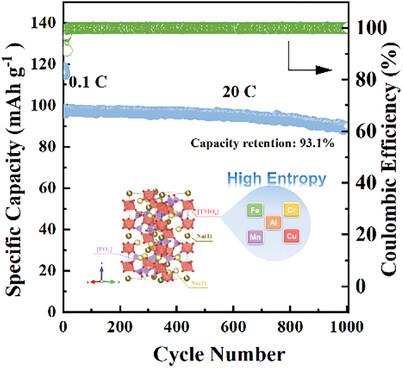Activating Reversible V4+/V5+ Redox Couple in NASICON-Type Phosphate Cathodes by High Entropy Substitution for Sodium-Ion Batteries
IF 13
2区 材料科学
Q1 CHEMISTRY, MULTIDISCIPLINARY
引用次数: 0
Abstract
Vanadium-based Na superionic conductor (NASICON) type materials (NaxVM(PO4)3, M = transition metals) have attracted extensive attention when used as sodium-ion batteries (SIBs) cathodes due to their stable structures and large Na+ diffusion channels. However, the materials have poor electrical conductivity and mediocre energy density, which hinder their practical applications. Activating the V4+/V5+ redox couple (V4+/V5+≈4.1 V vs Na+/Na) is an effective way to elevate the energy density of SIBs, whereas the irreversible phase transition of V4+/V5+ and severe structural distortion will inevitably result in fast capacity fading and unsatisfactory rate capability. Herein, a high entropy regulation strategy is proposed to optimize the detailed crystal structure and improve the reversibility of crystalline phase transformation and electrical conductivity of the material. With the activated reversible V4+/V5+ redox couple, stable structure, and fast electrochemical kinetics, the high entropy material Na3.2V1.5Fe0.1Al0.1Cr0.1Mn0.1Cu0.1(PO4)3 (NVMP-HE) exhibits an outstanding electrochemical performance with highly reversible specific capacity of 120.1 mAh g−1 at 0.1 C and excellent cycling stability (92.4% retention after 1000 cycles at 20 C). Besides, the in situ X-ray diffraction (XRD) measurement reveals that a smooth three-phase transition reaction is involved in this high-entropy cathode and the existence of mesophase facilitates a fast phase transition.

求助全文
约1分钟内获得全文
求助全文
来源期刊

Small
工程技术-材料科学:综合
CiteScore
17.70
自引率
3.80%
发文量
1830
审稿时长
2.1 months
期刊介绍:
Small serves as an exceptional platform for both experimental and theoretical studies in fundamental and applied interdisciplinary research at the nano- and microscale. The journal offers a compelling mix of peer-reviewed Research Articles, Reviews, Perspectives, and Comments.
With a remarkable 2022 Journal Impact Factor of 13.3 (Journal Citation Reports from Clarivate Analytics, 2023), Small remains among the top multidisciplinary journals, covering a wide range of topics at the interface of materials science, chemistry, physics, engineering, medicine, and biology.
Small's readership includes biochemists, biologists, biomedical scientists, chemists, engineers, information technologists, materials scientists, physicists, and theoreticians alike.
 求助内容:
求助内容: 应助结果提醒方式:
应助结果提醒方式:


